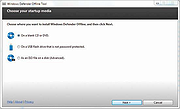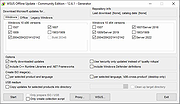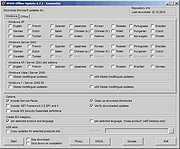 |
Windows Defender Offline 32bit
Windows Defender Offline 32bit
What is Windows Defender Offline?
Sometimes, malicious and other potentially unwanted software, including rootkits, try to install themselves on your PC. This can happen when you connect to the Internet or install some programs from a CD, DVD, or other media. Once on your PC, this software might run immediately, or it might run at unexpected times. Windows Defender Offline can help remove such hard to find malicious and potentially unwanted programs using definitions that recognize threats. Definitions are files that provide an encyclopedia of potential software threats. Because new threats appear daily, it's important to always have the most up-to-date definitions installed in Windows Defender Offline. Armed with definition files, Windows Defender Offline can detect malicious and potentially unwanted software, and then notify you of the risks.
To use Windows Defender Offline, you need to follow four basic steps:
1) Download Windows Defender Offline and create a CD, DVD, or USB flash drive.
2) Restart your PC using the Windows Defender Offline media.
3) Scan your PC for malicious and other potentially unwanted software.
4) Remove any malware that is found from your PC.
Windows Defender Offline will walk you through the details of these four steps when you're using the tool. If you've been prompted in Microsoft Security Essentials or Windows Defender to download and run Windows Defender Offline, it's important that you do so, to make sure that your data and your PC isn't compromised.
To get started, find a blank CD, DVD, or USB flash drive with at least 250 MB of free space and then download and run the tool—the tool will help you create the removable media.
Note
We recommend that you download Windows Defender Offline and create the CD, DVD, or USB flash drive on a PC ... |
 |
6,082 |
Nov 29, 2019
Microsoft  |
 |
Windows Defender Offline 64bit
Windows Defender Offline 64bit
What is Windows Defender Offline?
Sometimes, malicious and other potentially unwanted software, including rootkits, try to install themselves on your PC. This can happen when you connect to the Internet or install some programs from a CD, DVD, or other media. Once on your PC, this software might run immediately, or it might run at unexpected times. Windows Defender Offline can help remove such hard to find malicious and potentially unwanted programs using definitions that recognize threats. Definitions are files that provide an encyclopedia of potential software threats. Because new threats appear daily, it's important to always have the most up-to-date definitions installed in Windows Defender Offline. Armed with definition files, Windows Defender Offline can detect malicious and potentially unwanted software, and then notify you of the risks.
To use Windows Defender Offline, you need to follow four basic steps:
1) Download Windows Defender Offline and create a CD, DVD, or USB flash drive.
2) Restart your PC using the Windows Defender Offline media.
3) Scan your PC for malicious and other potentially unwanted software.
4) Remove any malware that is found from your PC.
Windows Defender Offline will walk you through the details of these four steps when you're using the tool. If you've been prompted in Microsoft Security Essentials or Windows Defender to download and run Windows Defender Offline, it's important that you do so, to make sure that your data and your PC isn't compromised.
To get started, find a blank CD, DVD, or USB flash drive with at least 250 MB of free space and then download and run the tool—the tool will help you create the removable media.
Note
We recommend that you download Windows Defender Offline and create the CD, DVD, or USB flash drive on a PC ... |
 |
6,027 |
Nov 29, 2019
Microsoft  |
 |
WSUS Offline Update Community Edition v12.6.1
WSUS Offline Update Community Edition v12.6.1
A community-driven fork of WSUS Offline Update.
The open source project formerly known as "c't offline update" or "DIY Service Pack" (published at "The H"), later dubbed "WSUS Offline Update" (and maintained by its original author, Torsten Wittrock), is now be continued by the Community.
Using "WSUS Offline Update Community Edition", you can update any computer running Microsoft Windows and Office safely, quickly and without an Internet connection.
Requirements:
Windows 7, 8, 8.1, 10 (Windows 11 version is currently being developed), Server up to 2019.
Click here to visit the author's website. |
 |
1,865 |
Aug 05, 2022
Torsten Wittrock  |
 |
WSUS Offline Update v12.0
WSUS Offline Update v12.0
Using WSUS Offline Update, you can update any computer running Microsoft Windows safely, quickly and without an Internet connection.
Modifications in version 12.0
- Support removed for Windows 7 and Server 2008(R2) since Microsoft discontinued support for it on January 14th, 2020
- Support removed for Microsoft Security Essentials, Windows 7 Defender, Service Packs, Remote Desktop Client and Silverlight (download switches /includemsse and /excludesp, update switches /instmsse, /instmssl and /updatetsc)
- Support removed for Windows 10 version 1703 since Microsoft discontinued support for it on October 8th, 2019
- Split Windows 10 download into version specific parts
- Included complete rewrite of the Linux scripts version 1.19 (Special thanks to H. Buhrmester)
- March 2020 updates added to 'security only' lists for Windows 8.1 and Server 2012 / 2012 R2 (x86/x64) systems
- Included improved XSLT filter for the determination of dynamic Office updates by Product Id rather than ProductFamily Id (Special thanks to H. Buhrmester)
- Replaced superseded November 2019 Servicing stack update (kb4523200) by March 2020 Servicing stack update (kb4540721) for Windows 10 Version 1507 (Thanks to "aker")
- Replaced superseded November 2019 Servicing stack update (kb4520724) by March 2020 Servicing stack update (kb4540723) for Windows 10 Version 1607 and Windows Server 2016 (Thanks to "aker")
- Replaced superseded November 2019 Servicing stack update (kb4523202) by March 2020 Servicing stack update (kb4541731) for Windows 10 Version 1709 (Thanks to "aker")
- Replaced superseded November 2019 Servicing stack update (kb4523203) by March 2020 Servicing stack update (kb4540724) for Windows 10 Version 1803 (Thanks to "aker")
- Replaced superseded November 2019 Servicing stack update (kb4523204) by March 2020 Servicing stack update (kb4539571) for Windows 10 Version 1809 and Windows Server 2019 (Thanks to "aker")
- Replaced superseded February 2020 Servicing stack update (kb4538674) by March 2020 Servicing stack update (kb4541338) for Windows 10 Version 1903 and 1909 (Thanks ... |
 |
10,069 |
Jun 22, 2021
Torsten Wittrock  |















